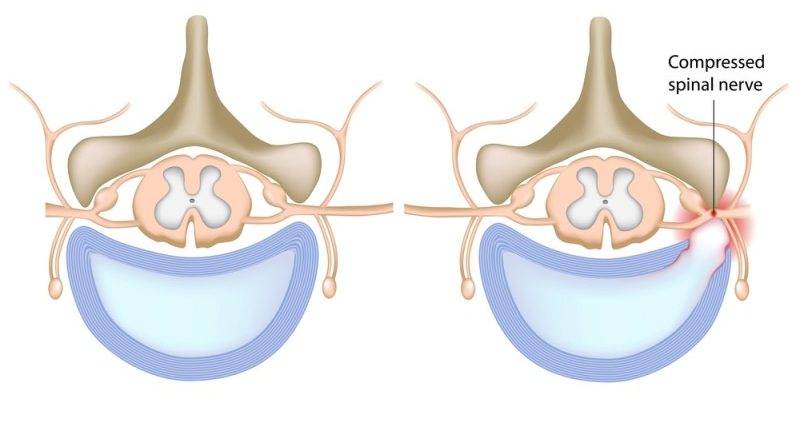Contents
A herniated disc is a common problem that occurs due to poor posture, being overweight, improper lifting, and other factors. This can be a very painful condition, prompting people to come to massage therapists with high hopes of significant pain relief. But it is important to know some of the nuances so that the massage does not harm.
A herniated disc is a malfunction of the soft, jelly-like discs between the vertebrae. These discs absorb shock from the vertebrae as we move, protecting the bones and nerves that run throughout the body from the spinal cord. When damaged, they often bulge and burst, and this is called a herniated or displaced intervertebral disc.
Signs of a herniated disc may include unexplained pain in the arms and legs, numbness or tingling, or weakness in the arms and legs. Decreased muscle strength, loss of reflexes and the ability to walk, or the ability to feel light touch, and changes in bowel and bladder frequency. Most often, herniated discs occur in the lumbar region or neck.
Sometimes, when one of these discs is damaged, there is no pain and we don’t know about it unless we do an MRI (magnetic resonance imaging), CT scan, or myelograms (where a dye is injected into the cerebrospinal fluid so that x-rays can show structures) . In other cases, severe pain associated with a herniated disc may occur as the nerves and bones are compressed without cushioning.
There are many causes of herniated discs: wear and tear that occurs with age, excessive body weight, spinal injuries, poor posture, or poor exercise or heavy lifting habits. Surgery is often required to repair the damage, but sometimes these discs can heal on their own in a few months.
The benefits of massage for a hernia of the spine for adults
Pain from herniated discs can range from mild to severe. Here are some tips for avoiding pain:
- do not lift anything heavy and be sure to use proper body mechanics when lifting – bend your knees, lift weights by straightening your legs, not jerking your back;
- apply ice packs to the sore spot for 15 to 20 minutes;
- consistently perform exercises recommended by a doctor or a physiotherapist to strengthen the muscles of the back and abs;
- take over-the-counter pain relievers, muscle relaxants or cortisone injections – your doctor will be able to prescribe the right medication depending on your level of pain.
In some cases, massage helps some patients – it is believed that it maintains the tone of muscle tissue and relieves stress from the spine. Massage will not heal or repair a herniated disc, but when done on the surrounding tissues, it can help by improving circulation, restoring muscle flexibility and range of motion. True, experienced doctors still do not recommend doing it for hernias (see below).
The harm of massage with a hernia of the spine for adults
Massage directly on a herniated disc is contraindicated, as is pressure directly on a damaged disc, as this can aggravate the condition and increase pain.
If the patient has any serious symptoms, such as loss of bladder or bowel control, a doctor’s approval should be obtained as a precaution before massage.
Massage contraindications for spinal hernia for adults
There are a number of prohibitions on massage in the presence of herniated discs:
- the large size of the hernia and its dangerous localization;
- exacerbation of pain syndrome;
- development of inflammatory processes, acute infections;
- open wound surfaces, pustular lesions in the massage area;
- feverish conditions;
- cardiovascular disease (including hypertension);
- menstruation and pregnancy;
- any type of cancer.
Massage is also not recommended after spinal surgery.
How to massage with a hernia of the spine for adults at home
Massage for vertebral hernia, if the patient wants it, should be carried out only by an experienced massage therapist. He will work the muscles on either side of the spine and throughout the area to restore range of motion, lengthen muscle tissue, and increase blood circulation in those areas.
When working with the damaged disc area, most of the same techniques are used that are used during any therapeutic massage – only with more care! Specific methods will be determined by the particular damaged drive. This means assessing pain, checking frequently and warming up the area by slowly working deeper.
Basic massage techniques such as tingling and rubbing can be used to relax the tissues and provide relief. But it is important not to overdo it – it can cause pain. Therefore, a clear interaction between the doctor and the patient is important.
Expert Commentary
Massage for spinal hernia is very popular with patients, they often turn to masseurs for help, but doctors consider this activity useless and even dangerous. Here’s what he says about it doctor of physical therapy and sports medicine, traumatologist-orthopedist, rehabilitation specialist Georgy Temichev:
– Massage for a hernia in any part of the spine is not effective, since the main pain in a hernia is neuropathic, that is, it comes from a nerve, and not from soft tissues. Thus, massage in this condition does not have any particular effect other than irritating. General massage, without affecting the affected area, can be done, it will relax the muscles. But specifically with a hernia of the spine, it will not be effective. If you touch the affected area, you can increase the pain and discomfort.










